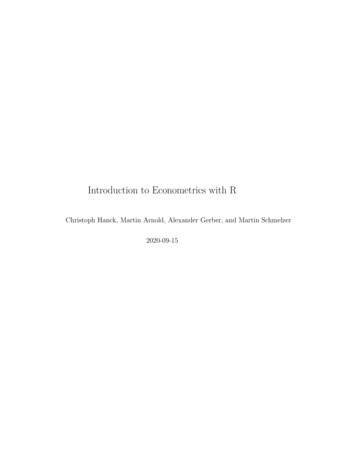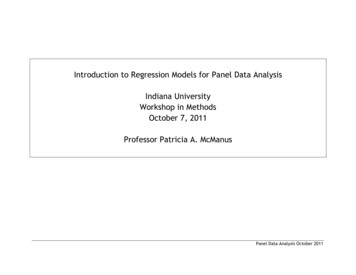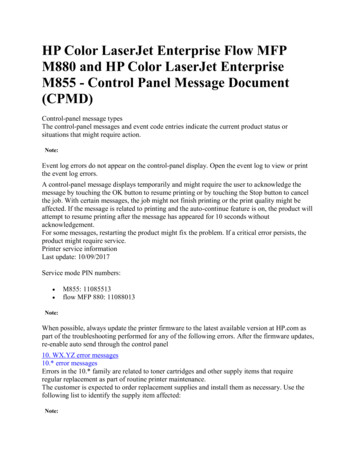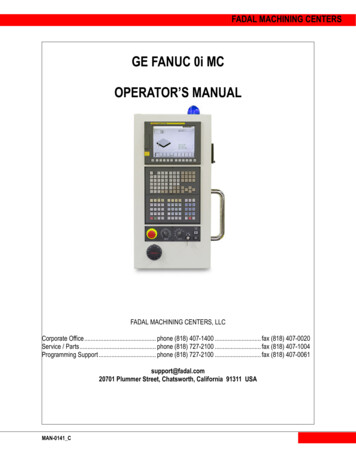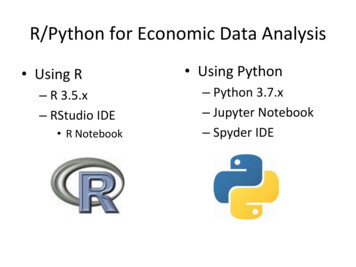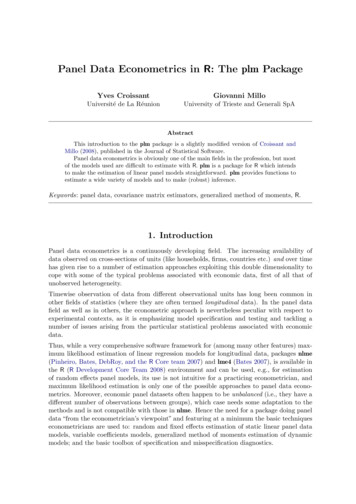
Transcription
Panel Data Econometrics in R: The plm PackageYves CroissantGiovanni MilloUniversité de La RéunionUniversity of Trieste and Generali SpAAbstractThis introduction to the plm package is a slightly modified version of Croissant andMillo (2008), published in the Journal of Statistical Software.Panel data econometrics is obviously one of the main fields in the profession, but mostof the models used are difficult to estimate with R. plm is a package for R which intendsto make the estimation of linear panel models straightforward. plm provides functions toestimate a wide variety of models and to make (robust) inference.Keywords: panel data, covariance matrix estimators, generalized method of moments, R.1. IntroductionPanel data econometrics is a continuously developing field. The increasing availability ofdata observed on cross-sections of units (like households, firms, countries etc.) and over timehas given rise to a number of estimation approaches exploiting this double dimensionality tocope with some of the typical problems associated with economic data, first of all that ofunobserved heterogeneity.Timewise observation of data from different observational units has long been common inother fields of statistics (where they are often termed longitudinal data). In the panel datafield as well as in others, the econometric approach is nevertheless peculiar with respect toexperimental contexts, as it is emphasizing model specification and testing and tackling anumber of issues arising from the particular statistical problems associated with economicdata.Thus, while a very comprehensive software framework for (among many other features) maximum likelihood estimation of linear regression models for longitudinal data, packages nlme(Pinheiro, Bates, DebRoy, and the R Core team 2007) and lme4 (Bates 2007), is available inthe R (R Development Core Team 2008) environment and can be used, e.g., for estimationof random effects panel models, its use is not intuitive for a practicing econometrician, andmaximum likelihood estimation is only one of the possible approaches to panel data econometrics. Moreover, economic panel datasets often happen to be unbalanced (i.e., they have adifferent number of observations between groups), which case needs some adaptation to themethods and is not compatible with those in nlme. Hence the need for a package doing paneldata “from the econometrician’s viewpoint” and featuring at a minimum the basic techniqueseconometricians are used to: random and fixed effects estimation of static linear panel datamodels, variable coefficients models, generalized method of moments estimation of dynamicmodels; and the basic toolbox of specification and misspecification diagnostics.
2Panel Data Econometrics in R: The plm PackageFurthermore, we felt there was the need for automation of some basic data managementtasks such as lagging, summing and, more in general, applying (in the R sense) functionsto the data, which, although conceptually simple, become cumbersome and error-prone ontwo-dimensional data, especially in the case of unbalanced panels.This paper is organized as follows: Section 2 presents a very short overview of the typicalmodel taxonomy1 . Section 3 discusses the software approach used in the package. The nextthree sections present the functionalities of the package in more detail: data management(Section 4), estimation (Section 5) and testing (Section 6), giving a short description andillustrating them with examples. Section 7 compares the approach in plm to that of nlmeand lme4, highlighting the features of the latter two that an econometrician might find mostuseful. Section 8 concludes the paper.2. The linear panel modelThe basic linear panel models used in econometrics can be described through suitable restrictions of the following general model:yit αit βit xit uit(1)where i 1, . . . n is the individual (group, country . . . ) index, t 1, . . . T is the time indexand uit a random disturbance term of mean 0.Of course uit is not estimable with N n T data points. A number of assumptions areusually made about the parameters, the errors and the exogeneity of the regressors, givingrise to a taxonomy of feasible models for panel data.The most common one is parameter homogeneity, which means that αit α for all i, t andβit β for all i, t. The resulting modelyit α β xit uit(2)is a standard linear model pooling all the data across i and t.To model individual heterogeneity, one often assumes that the error term has two separatecomponents, one of which is specific to the individual and doesn’t change over time2 . This iscalled the unobserved effects model:yit α β xit µi it(3)The appropriate estimation method for this model depends on the properties of the two errorcomponents. The idiosyncratic error it is usually assumed well-behaved and independent ofboth the regressors xit and the individual error component µi . The individual componentmay be in turn either independent of the regressors or correlated.If it is correlated, the ordinary least squares (ols) estimator of β would be inconsistent, soit is customary to treat the µi as a further set of n parameters to be estimated, as if in the1Comprehensive treatments are to be found in many econometrics textbooks, e.g. Baltagi (2001) orWooldridge (2002): the reader is referred to these, especially to the first 9 chapters of Baltagi (2001).2For the sake of exposition we are considering only the individual effects case here. There may also be timeeffects, which is a symmetric case, or both of them, so that the error has three components: uit µi λt it .
Yves Croissant, Giovanni Millo3general model αit αi for all t. This is called the fixed effects (a.k.a. within or least squaresdummy variables) model, usually estimated by ols on transformed data, and gives consistentestimates for β.If the individual-specific component µi is uncorrelated with the regressors, a situation which isusually termed random effects, the overall error uit also is, so the ols estimator is consistent.Nevertheless, the common error component over individuals induces correlation across thecomposite error terms, making ols estimation inefficient, so one has to resort to some formof feasible generalized least squares (gls) estimators. This is based on the estimation of thevariance of the two error components, for which there are a number of different proceduresavailable.If the individual component is missing altogether, pooled ols is the most efficient estimatorfor β. This set of assumptions is usually labelled pooling model, although this actually refersto the errors’ properties and the appropriate estimation method rather than the model itself.If one relaxes the usual hypotheses of well-behaved, white noise errors and allows for theidiosyncratic error it to be arbitrarily heteroskedastic and serially correlated over time, a moregeneral kind of feasible gls is needed, called the unrestricted or general gls. This specificationcan also be augmented with individual-specific error components possibly correlated with theregressors, in which case it is termed fixed effects gls.Another way of estimating unobserved effects models through removing time-invariant individual components is by first-differencing the data: lagging the model and subtracting, thetime-invariant components (the intercept and the individual error component) are eliminated,and the model yit β xit uit(4)(where yit yit yi,t 1 , xit xit xi,t 1 and, from (3), uit uit ui,t 1 it fort 2, ., T ) can be consistently estimated by pooled ols. This is called the first-difference,or fd estimator. Its relative efficiency, and so reasons for choosing it against other consistentalternatives, depends on the properties of the error term. The fd estimator is usually preferredif the errors uit are strongly persistent in time, because then the uit will tend to be seriallyuncorrelated.Lastly, the between model, which is computed on time (group) averages of the data, discardsall the information due to intragroup variability but is consistent in some settings (e.g., nonstationarity) where the others are not, and is often preferred to estimate long-run relationships.Variable coefficients models relax the assumption that βit β for all i, t. Fixed coefficientsmodels allow the coefficients to vary along one dimension, like βit βi for all t. Randomcoefficients models instead assume that coefficients vary randomly around a common average,as βit β ηi for all t, where ηi is a group– (time–) specific effect with mean zero.The hypotheses on parameters and error terms (and hence the choice of the most appropriateestimator) are usually tested by means of: pooling tests to check poolability, i.e. the hypothesis that the same coefficients applyacross all individuals, if the homogeneity assumption over the coefficients is established, the next step is toestablish the presence of unobserved effects, comparing the null of spherical residualswith the alternative of group (time) specific effects in the error term,
4Panel Data Econometrics in R: The plm Package the choice between fixed and random effects specifications is based on Hausman-typetests, comparing the two estimators under the null of no significant difference: if this isnot rejected, the more efficient random effects estimator is chosen, even after this step, departures of the error structure from sphericity can further affectinference, so that either screening tests or robust diagnostics are needed.Dynamic models and in general lack of strict exogeneity of the regressors, pose further problems to estimation which are usually dealt with in the generalized method of moments (gmm)framework.These were, in our opinion, the basic requirements of a panel data econometrics packagefor the R language and environment. Some, as often happens with R, were already fulfilledby packages developed for other branches of computational statistics, while others (like thefixed effects or the between estimators) were straightforward to compute after transformingthe data, but in every case there were either language inconsistencies w.r.t. the standardeconometric toolbox or subtleties to be dealt with (like, for example, appropriate computationof standard errors for the demeaned model, a common pitfall), so we felt there was need for an“all in one” econometrics-oriented package allowing to make specification searches, estimationand inference in a natural way.3. Software approach3.1. Data structurePanel data have a special structure: each row of the data corresponds to a specific individualand time period. In plm the data argument may be an ordinary data.frame but, in thiscase, an argument called index has to be added to indicate the structure of the data. Thiscan be: NULL (the default value), it is then assumed that the first two columns contain theindividual and the time index and that observations are ordered by individual and bytime period, a character string, which should be the name of the individual index, a character vector of length two containing the names of the individual and the timeindex, an integer which is the number of individuals (only in case of a balanced panel withobservations ordered by individual).The pdata.frame function is then called internally, which returns a pdata.frame which isa data.frame with an attribute called index. This attribute is a data.frame that containsthe individual and the time indexes.It is also possible to use directly the pdata.frame function and then to use the pdata.framein the estimation functions.
Yves Croissant, Giovanni Millo53.2. InterfaceEstimation interfaceplm provides four functions for estimation: plm: estimation of the basic panel models, i.e. within, between and random effectmodels. Models are estimated using the lm function to transformed data, pvcm: estimation of models with variable coefficients, pgmm: estimation of generalized method of moments models, pggls: estimation of general feasible generalized least squares models.The interface of these functions is consistent with the lm() function. Namely, their first twoarguments are formula and data (which should be a data.frame and is mandatory). Threeadditional arguments are common to these functions: index: this argument enables the estimation functions to identify the structure of thedata, i.e. the individual and the time period for each observation, effect: the kind of effects to include in the model, i.e. individual effects, time effectsor both3 , model: the kind of model to be estimated, most of the time a model with fixed effectsor a model with random effects.The results of these four functions are stored in an object which class has the same nameof the function. They all inherit from class panelmodel. A panelmodel object contains:coefficients, residuals, fitted.values, vcov, df.residual and call and functions thatextract these elements are provided.Testing interfaceThe diagnostic testing interface provides both formula and panelmodel methods for mostfunctions, with some exceptions. The user may thus choose whether to employ results storedin a previously estimated panelmodel object or to re-estimate it for the sake of testing.Although the first strategy is the most efficient one, diagnostic testing on panel models mostlyemploys ols residuals from pooling model objects, whose estimation is computationally inexpensive. Therefore most examples in the following are based on formula methods, whichare perhaps the cleanest for illustrative purposes.3Although in most models the individual and time effects cases are symmetric, there are exceptions: estimating the fd model on time effects is meaningless because cross-sections do not generally have a naturalordering, so trying effect "time" stops with an error message as does effect "twoways" which is not definedfor fd models.
6Panel Data Econometrics in R: The plm Package3.3. Computational approach to estimationThe feasible gls methods needed for efficient estimation of unobserved effects models havea simple closed-form solution: once the variance components have been estimated and hencethe covariance matrix of errors V̂ , model parameters can be estimated asβ̂ (X V̂ 1 X) 1 (X V̂ 1 y)(5)Nevertheless, in practice plain computation of β̂ has long been an intractable problem evenfor moderate-sized datasets because of the need to invert the N N V̂ matrix. With theadvances in computer power, this is no more so, and it is possible to program the “naive”estimator (5) in R with standard matrix algebra operators and have it working seamlessly forthe standard “guinea pigs”, e.g. the Grunfeld data. Estimation with a couple of thousandsof data points also becomes feasible on a modern machine, although excruciatingly slow anddefinitely not suitable for everyday econometric practice. Memory limits would also be verynear because of the storage needs related to the huge V̂ matrix. An established solutionexists for the random effects model which reduces the problem to an ordinary least squarescomputation.The (quasi–)demeaning frameworkThe estimation methods for the basic models in panel data econometrics, the pooled ols, random effects and fixed effects (or within) models, can all be described inside the ols estimationframework. In fact, while pooled ols simply pools data, the standard way of estimating fixedeffects models with, say, group (time) effects entails transforming the data by subtracting theaverage over time (group) to every variable, which is usually termed time-demeaning. In therandom effects case, the various feasible gls estimators which have been put forth to tacklethe issue of serial correlation induced by the group-invariant random effect have been provento be equivalent (as far as estimation of βs is concerned) to ols on partially demeaned data,where partial demeaning is defined as:yit θȳi (Xit θX̄i )β (uit θūi )(6)where θ 1 [σu2 /(σu2 T σe2 )]1/2 , ȳ and X̄ denote time means of y and X, and the disturbancevit θv̄i is homoskedastic and serially uncorrelated. Thus the feasible re estimate for β maybe obtained estimating θ̂ and running an ols regression on the transformed data with lm().The other estimators can be computed as special cases: for θ 1 one gets the fixed effectsestimator, for θ 0 the pooled ols one.Moreover, instrumental variable estimators of all these models may also be obtained usingseveral calls to lm().For this reason the three above estimators have been grouped inside the same function.On the output side, a number of diagnostics and a very general coefficients’ covariance matrixestimator also benefits from this framework, as they can be readily calculated applying thestandard ols formulas to the demeaned data, which are contained inside plm objects. Thiswill be the subject of Subsection 3.4.
Yves Croissant, Giovanni Millo7The object oriented approach to general GLS computationsThe covariance matrix of errors in general gls models is too generic to fit the quasi-demeaningframework, so this method calls for a full-blown application of gls as in (5). On the otherhand, this estimator relies heavily on n–asymptotics, making it theoretically most suitablefor situations which forbid it computationally: e.g., “short” micropanels with thousands ofindividuals observed over few time periods.R has general facilities for fast matrix computation based on object orientation: particulartypes of matrices (symmetric, sparse, dense etc.) are assigned the relevant class and theadditional information on structure is used in the computations, sometimes with dramaticeffects on performance (see Bates 2004) and packages Matrix (see Bates and Maechler 2016)and SparseM (see Koenker and Ng 2016). Some optimized linear algebra routines are availablein the R package bdsmatrix (see Therneau 2014) which exploit the particular block-diagonaland symmetric structure of V̂ making it possible to implement a fast and reliable full-matrixsolution to problems of any practically relevant size.The V̂ matrix is constructed as an object of class bdsmatrix. The peculiar properties of thismatrix class are used for efficiently storing the object in memory and then by ad-hoc versionsof the solve and crossprod methods, dramatically reducing computing times and memoryusage. The resulting matrix is then used “the naive way” as in (5) to compute β̂, resulting inspeed comparable to that of the demeaning solution.3.4. Inference in the panel modelGeneral frameworks for restrictions and linear hypotheses testing are available in the R environment4 . These are based on the Wald test, constructed as β̂ V̂ 1 β̂, where β̂ and V̂ areconsistent estimates of β and V (β), The Wald test may be used for zero-restriction (i.e., significance) testing and, more generally, for linear hypotheses in the form (Rβ̂ r) [RV̂ R ] 1 (Rβ̂ r)5 . To be applicable, the test functions require extractor methods for coefficients’ and covariance matrix estimates to be defined for the model object to be tested. Model objects in plmall have coef() and vcov() methods and are therefore compatible with the above functions.In the same framework, robust inference is accomplished substituting (“plugging in”) a robustestimate of the coefficient covariance matrix into the Wald statistic formula. In the panelcontext, the estimator of choice is the White system estimator. This called for a flexiblemethod for computing robust coefficient covariance matrices à la White for plm objects.A general White system estimator for panel data is:V̂R (β) (X X) 1nXXi Ei Xi (X X) 1(7)i 1where Ei is a function of the residuals êit , t 1, . . . T chosen according to the relevant heteroskedasticity and correlation structure. Moreover, it turns out that the White covariancematrix calculated on the demeaned model’s regressors and residuals (both part of plm objects) is a consistent estimator of the relevant model’s parameters’ covariance matrix, thus the4See packages lmtest (Hothorn, Zeileis, Farebrother, Cummins, Millo, and Mitchell 2015) and car (Fox2016).5Moreover, coeftest() provides a compact way of looking at coefficient estimates and significance diagnostics.
8Panel Data Econometrics in R: The plm Packagemethod is readily applicable to models estimated by random or fixed effects, first differenceor pooled ols methods. Different pre-weighting schemes taken from package sandwich (seeZeileis 2004; Lumley and Zeileis 2015) are also implemented to improve small-sample performance. Robust estimators with any combination of covariance structures and weightingschemes can be passed on to the testing functions.4. Managing data and formulaeThe package is now illustrated by application to some well-known examples. It is loaded usingR library("plm")The four datasets used are EmplUK which was used by Arellano and Bond (1991), the Grunfelddata (Kleiber and Zeileis 2008) which is used in several econometric books, the Produc dataused by Munnell (1990) and the Wages used by Cornwell and Rupert (1988).R R R R data("EmplUK", package "plm")data("Produc", package "plm")data("Grunfeld", package "plm")data("Wages", package "plm")4.1. Data structureAs observed above, the current version of plm is capable of working with a regular data.framewithout any further transformation, provided that the individual and time indexes are in thefirst two columns, as in all the example datasets but Wages. If this weren’t the case, an indexoptional argument would have to be passed on to the estimating and testing functions.R 19391940inv317.6391.8410.6257.7330.8461.2value 13.2203.44643.9207.2R E - pdata.frame(EmplUK, index c("firm","year"), drop.index TRUE, row.names TRUE)R 77777emp5.0415.6005.0154.7154.0933.166wage capitaloutput13.1516 0.5894 95.707212.3018 0.6318 97.356912.8395 0.6771 99.608313.8039 0.6171 100.550114.2897 0.5076 99.558114.8681 0.4229 98.6151
Yves Croissant, Giovanni Millo9R head(attr(E, 982Two further arguments are logical : drop.index drop the indexes from the data.frame androw.names computes “fancy” row names by pasting the individual and the time indexes. Whileextracting a series from a pdata.frame, a pseries is created, which is the original serieswith the index attribute. This object has specific methods, like summary and as.matrixare provided. The former indicates the total variation of the variable and the share of thisvariation that is due to the individual and the time dimensions. The latter gives the matrixrepresentation of the series, with, by default, individual as rows and time as columns.R summary(E emp)total sum of squares : 261539.4idtime0.980765381 0.009108488R head(as.matrix(E 919.57027.16982.7000.77919821983 19843.166 2.936NA72.419 68.518NA18.125 16.850NA24.504 22.562NA73.700NANA0.782NANA4.2. Data transformationPanel data estimation requires to apply different transformations to raw series. If x is a seriesof length nT (where n is the number of individuals and T is the number of time periods), thetransformed series x̃ is obtained as x̃ M x where M is a transformation matrix. Denotingj a vector of one of length T and In the identity matrix of dimension n, we get: the between transformation: P T1 In jj 0 returns a vector containing the individualmeans. The Between and between functions performs this operation, the first onereturning a vector of length nT , the second one a vector of length n, the within transformation: Q InT P returns a vector containing the values indeviation from the individual means. The Within function performs this operation.
10Panel Data Econometrics in R: The plm Package the first difference transformation D In d where d 1 1 00 .0 1 1 0 . . .0 01 1 . . . . .0 000 .000.000. 1 1is of dimension (T 1, T ).Note that R’s diff() and lag() functions don’t compute correctly these transformationsfor panel data because they are unable to identify when there is a change in individualin the data. Specific methods for pseries objects are therefore have been rewritten inorder to handle correctly panel data. Note that compares to the lag method for tsobjects, the order of lags are indicated by positive integer. Moreover, 0 is a relevantvalue and a vector argument may be provided:R head(lag(E emp, 2NANA5.0415.6005.0154.715Further functions called Between, between and Within are also provided to compute thebetween and the within transformation. The between returns unique values, whereasBetween duplicates the values and returns a vector which length is the number of observations.R head(diff(E emp), 10)1-19771-19781-19791-19801-19811-19821-1983NA 0.5590000 -0.5850000 -0.2999997 -0.6220003 -0.9270000 -0.22999982-19772-19782-1979NA -0.6760020 0.2750010R head(lag(E emp, 2), 10)1-1977 1-1978 1-1979 1-1980 1-1981 1-1982 1-1983 2-1977 2-1978 2-1979NANA 5.041 5.600 5.015 4.715 4.093NANA 71.319R head(Within(E R head(between(E emp), 4)1-19801-19811-19820.3484288 -0.2735715 -1.2005715
Yves Croissant, Giovanni Millo1112344.366571 71.362428 19.040143 26.035000R head(Between(E emp), 10)114.366571 4.3665712271.362428 66571 71.3624284.3. FormulasThere are circumstances where standard formula are not very useful to describe a model,notably while using instrumental variable like estimators: to deal with these situations, weuse the Formula package.The Formula package provides a class which enables to construct multi-part formula, eachpart being separated by a pipe sign. plm provides a pFormula object which is a Formula withspecific methods.The two formulas below are identical:R emp wage capital lag(wage,1) capitalemp wage capital lag(wage, 1) capitalR emp wage capital .-wage lag(wage,1)emp wage capital . - wage lag(wage, 1)In the second case, the . means the previous parts which describes the covariates and thispart is “updated”. This is particularly interesting when there are a few external instruments.5. Model estimation5.1. Estimation of the basic models with plmSeveral models can be estimated with plm by filling the model argument: the fixed effects model (within), the pooling model (pooling), the first-difference model (fd), the between model (between), the error components model (random).
12Panel Data Econometrics in R: The plm PackageThe basic use of plm is to indicate the model formula, the data and the model to be estimated.For example, the fixed effects model and the random effects model are estimated using:R grun.fe - plm(inv value capital, data Grunfeld, model "within")R grun.re - plm(inv value capital, data Grunfeld, model "random")R summary(grun.re)Oneway (individual) effect Random Effect Model(Swamy-Arora's transformation)Call:plm(formula inv value capital, data Grunfeld, model "random")Balanced Panel: n 10, T 20, N 200Effects:var std.dev shareidiosyncratic 2784.4652.77 0.282individual7089.8084.20 0.718theta: 0.8612Residuals :Min. 1st Qu.-178.00 -19.70Median 3rd Qu.4.6919.50Max.253.00Coefficients :Estimate Std. Error t-value Pr( t )(Intercept) -57.834415 28.898935 -2.0013 0.04674 *value0.1097810.010493 10.4627 2e-16 ***capital0.3081130.017180 17.9339 2e-16 ***--Signif. codes: 0 '***' 0.001 '**' 0.01 '*' 0.05 '.' 0.1 ' ' 1Total Sum of Squares:2381400Residual Sum of Squares: 548900R-Squared:0.7695Adj. R-Squared: 0.76716F-statistic: 328.837 on 2 and 197 DF, p-value: 2.22e-16For a random model, the summary method gives information about the variance of the components of the errors. Fixed effects may be extracted easily using fixef. An argument typeindicates how fixed effects should be computed : in level type ’level’ (the default), indeviation from the overall mean type ’dmean’ or in deviation from the first individualtype ’dfirst’.R fixef(grun.fe, type 'dmean')
Yves Croissant, Giovanni Millo1-11.5527787-7.80953423160.649753 -176.827902891.198282 2644The fixef function returns an object of class fixef. A summary method is provided, whichprints the effects (in deviation from the overall intercept), their standard errors and the testof equality to the overall intercept.R summary(fixef(grun.fe, type 'dmean'))Estimate Std. Error1-11.552849.70802160.649824.93833 12.89191052.176111.8269--Signif. codes: 0 7-0.60810.0856-2.20904.4116Pr( t *******0.001 '**' 0.01 '*' 0.05 '.' 0.1 ' ' 1In case of a two-ways effect model, an additional argument effect is required to extract fixedeffects:R grun.twfe - plm(inv value capital,data Grunfeld,model "within",effect "twoways")R fixef(grun.twfe,effect "time")19351936-32.83632 -52.0337219421943-53.97611 -75.8139419491950-106.33142 93819391940-72.06272 -102.30660 -77.07140194519461947-88.51936 -64.00560 -72.22856195219531954-97.46866 -100.55428 -126.362541941-51.640781948-76.552835.2. More advanced use of plmRandom effects estimatorsAs observed above, the random effect model is obtained as a linear estimation on quasidemeaned data. The parameter of this transformation is obtained using pr
Oct 11, 2017 · the R (R Development Core Team2008) environment and can be used, e.g., for estimation of random e ects panel models, its use is not intuitive for a practicing econometrician, and maximum likelihood estimation is only one of the possible approaches to panel data econo-metrics. Moreover, econo

